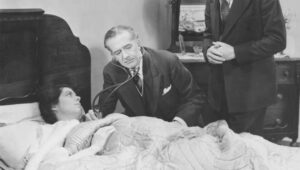Patient, Heal Thyself
One Man’s Informed Attempt to Navigate the Medical System
 Doctors, don’t get me started. My father was a doctor. One night, when I was 12 or 13, I was awakened by activity in the house. Sleepily I went downstairs, where I saw my father, fully dressed, about to go out. “Where’s Dad going?” I asked my mother. Your father is making a house call, I was told. One of his patients phoned. A sick person called and needed him.
Doctors, don’t get me started. My father was a doctor. One night, when I was 12 or 13, I was awakened by activity in the house. Sleepily I went downstairs, where I saw my father, fully dressed, about to go out. “Where’s Dad going?” I asked my mother. Your father is making a house call, I was told. One of his patients phoned. A sick person called and needed him.
A “house call.” Was it so very long ago that your family doctor would come to your bedside in the middle of the night? I’m 74, so yes, it was that long ago. Everything about American medical care has changed since my childhood. Some of the changes have been for the better, such as the enhanced understanding and treatment of disease, but the delivery of health care has become worse, not to mention its exorbitant cost.
Where to start? Your family doctor is now called the primary care provider (PCP), and you’d no more expect a visit at night from your PCP as you would from the man in the moon. Second, the PCP, when you do manage to see him or her at the clinic or office, may well be a nurse practitioner or physician assistant rather than an MD. This suggests an efficiency that saves the doctor’s time for the more difficult cases. Is U.S. health care better as a result? On the contrary, primary care is stretched thin today, nearly on the ropes. There’s a shortage of general practitioners and front-line providers. The emergence of nurse practitioners and physician assistants is backhanded evidence of the migration to the specialties, which pay doctors at higher scales than primary care does. The PCP’s main job these days is to refer patients to specialists if anything serious or puzzling is going on with their health. And when, referral(s) in hand, you walk uncertainly out of the PCP’s exam room—“No, to the left, Mr. Wheelwright, that way is the exit”—you’re on your own and good luck to you.
As a science and medical journalist for four decades, I’ve covered both the progress and shortfalls in medicine, always writing about them from a distance. I should have anticipated that one day I’d experience the changes in person. It happened this summer. Knocked overboard by a health issue, struggling to keep my head above water with no rescue coming from the medical system, I became my own doctor of sorts. I leveraged whatever biomedical research I could muster. Having learned from my physician-father to be skeptical of much medical practice, I didn’t hesitate to advocate for myself. I also had a like-minded sister, who is a physician assistant, advising me. Plus I had excellent insurance (Medicare and a secondary coverage) and a secure perch in society as a white male. In short, I was an atypical patient, armed to the teeth. But I faced a Hydra with no central intelligence, a Hydra that didn’t care how many of its heads I lopped off.
A warning, therefore, to the reader: The following is a reenactment of a true story. Do not try this at home except under medical supervision.
A few days after returning from a strenuous three-day hike in the mountains, I rather suddenly became dizzy. Simultaneously I had neck pain, and what felt like a clogged eustachian tube, and bouts of mild migraine with unsettling “aura” in my visual field. It felt like my head was being attacked by a virus of some kind. I was vaccinated for covid, but might it be a breakthrough infection? It didn’t match what I’d read about the breakthrough symptoms.
I tried resting for a few days. The neck pain subsided, and the other acute symptoms—but the dizziness continued. It wasn’t exactly vertigo, because the room did not spin, but it was difficult to walk since I was very unsteady. Exercise or just moving around in the garden was not possible. I thought I must have an inner-ear disorder, technically a vestibular disorder or labyrinthitis. However, as long as I didn’t shift my body, I didn’t feel ill. With my head still, I could read and work at the computer. Though I felt tired, my appetite and sleep were not disrupted.
I called the office of my PCP, Dr. M___. “He has no appointments open for a month,” the receptionist said. A month? Couldn’t he work me in sometime this week?
“If there’s a cancellation, he could,” I was told. But there were people on the list who were ahead of me. When I called back two days later, same story, except that the next available opening was even further out. The office told me moreover that I could not get on the cancellation list for Dr. M___ unless I already had an appointment with him.
Greatly annoyed, I declined to make an appointment. I need help now, I said. Well, I was told, depending on your symptoms, you can go to the emergency department at the hospital or to a Medstop or Urgent Care. In my area the latter are “doc in the box” clinics that serve patients on a first-come, first-serve basis.
 Previously a person in perfect health, I had seen Dr. M___ just twice, both times for my annual physical or “wellness” visit. He was very nice, very sharp. It was a shock to realize that I could get an appointment with Dr. M___ when I was well, but not when I was sick. Wasn’t that exactly backwards? I had no one to direct the bitter question to.
Previously a person in perfect health, I had seen Dr. M___ just twice, both times for my annual physical or “wellness” visit. He was very nice, very sharp. It was a shock to realize that I could get an appointment with Dr. M___ when I was well, but not when I was sick. Wasn’t that exactly backwards? I had no one to direct the bitter question to.
Dr. M___ was not his own boss. He worked under a contractual arrangement with a large health care company. Let’s call this big company Integrity Health. Where I live in California, Integrity Health has profoundly altered the market for medical services by buying up hospitals, clinics, laboratories, urgent care facilities and the providers themselves. With consolidation come economies of scale, which ought to lower costs, but more important for doctors like M___ were office services like billing, digital record-keeping, and malpractice insurance coverage. Solo practitioners in medicine are a dying breed mainly because they cannot keep up with the expensive, cumbersome, nonmedical requirements of their practices. To belong to a group is hardly new—my father shared coverage of patients with three other doctors—but the mega-corporate management of formerly independent physicians has deeply upset the doctor-patient relationship. Dr. M___ has to pay as much attention to Integrity Health’s performance targets as he does to patients. He probably gets a bonus for maintaining a certain volume. That’s why his schedule is constantly full. Having traded away part of his autonomy, M___ either couldn’t or wouldn’t make time for me.
I learned, besides, that the clinic was short a nurse practitioner. Ordinarily the NP would have tried to absorb M___’s extra patients. I was assured that Integrity Health would adjust the staffing, but for the moment I was out of luck.
Not feeling any better, I gave up and asked my wife to take me to an Urgent Care facility a half hour’s’ drive away. Owned by Integrity, the Urgent Care would record the results my visit and automatically relay them to providers like Dr. M___, should he ever return to my case.
The primary care provider I met with was a physician assistant. After conducting some basic tests, including an electrocardiogram (ECG), she was not sure what was wrong with me, other than to note an irregularity on the ECG. A heart problem possibly could be making me dizzy and weak. In addition to her cardiovascular suspicions, she allowed that a virus or bacteria could have caused the dizziness, and she ordered bloodwork. She recommended an over-the-counter antihistamine for the dizziness. It didn’t help.
I did not improve. When I tried one day to go for a walk, I found myself alarmingly out of breath. I went to Dr. M___’s office in person, and asked for the manager. This time I was offered an appointment two days hence with a nurse practitioner at an Integrity clinic in a different town. I took the appointment gratefully.
I was able that day to drive myself. The NP’s opinion, my bloodwork being negative, was that I needed to see a cardiologist. She wrote a referral to Coastal Cardiology, a group of specialists. “Anything else?” she asked me. She was not unkind but our time was up.
I had been ill for a month. On Sunday, the day before I hoped to schedule an appointment with a cardiologist, I hit bottom. A strong cup of coffee made me woozy, and after a violent sneeze (seasonal allergies), I nearly blacked out. I agreed to go to the ER. Before we left, I crawled into the bathroom, not able to stand.
Here’s where my case becomes interesting to a health journalist. The plot thickens, and not just because the hospital, one of two we might have chosen, was the crown jewel of Integrity Health’s medical facilities.
Sunday is a good day to visit the ER if you must, because the traffic accidents and other health complications of the work week are fewer. After a short wait with my wife in the flashy, donor-named waiting area, I was brought into the very impressive emergency services department, where I underwent a rapid-fire sequence of testing. My quaint tale about a virus attacking me did not catch the interest of Dr. A___, the attending physician, a handsome guy who looked like a surfer. Dr. A___ said that to test for covid would be pointless at this juncture. Positive or negative, the result wouldn’t help guide my treatment. So I had another ECG; two chest X-rays, one a high-tech CT scan with an injected contrast medium; an MRI scan of my brain; blood analysis; maybe some other things—and at last the culprit was found. Or so I believed.
Some years ago I wrote an essay about “mission creep” in U.S. medical care. As screening and diagnostic technologies have improved, ever more marginal conditions are being brought to light. Meanwhile, false positives have increased too: the detection of blips and bugs and subtle risk factors that do not pose a threat to the patient’s health. I sided with those medical critics who are concerned about “incidental” findings, the consequence of which is “overdiagnosis,” which in turn leads to unnecessary and sometimes harmful “overtreatment.” No therapy is without unwanted side effects and extra costs. But the specialists—cardiologists, urologists, neurologists and the rest, backed by the pharmaceutical and medical-device companies—have squelched the critics of our cascading medical technology. Americans, after all, demand and deserve the best care in the world. And Integrity Health, which each year sends fund-raising letters to the community for support of its latest diagnostic center or the like, is ready to help.
His muscular arms folded across his chest, Dr. A___ stood at the foot of my bed. “You have a small pulmonary embolism,” he declared. “A blood clot in your right lung. We don’t know how you got it. It usually comes from your legs. You will need to take a blood thinner for a while, so that you will be out of danger.” He didn’t have to tell me that pulmonary embolisms can be fatal. Dr. A___ probably addressed my dizziness and faintness too, but I don’t recall how he linked my symptoms to the embolism. Nevertheless, here was an answer. The doctor having done his job, I was released from the ER with a prescription for Xarelto, a blood thinner. I swallowed the first pill while still in my hospital gown. My wife drove me home.
In the following days I still was unsteady on my feet; my balance was not better. I still was breathless on short walks. I started to research the causes of blood clots and pulmonary embolism, and I read up on the blood thinners that are meant to prevent them. Xarelto was a relatively recent product. Though I had drug coverage subsidized by Medicare, the co-payment was going to be $500 per month, coming straight out of my pocket. The good news was that under a company program I could apply to receive the first month’s pills at no cost. Thereafter the company would discount the price of Xarelto for as long as I needed to take it, which was for at least six months. The most worrisome complication of an anticoagulant like Xarelto was internal bleeding, including bleeds within the skull. I would have to be especially careful about cuts. Though the risks were low, the downside statistics were clear. OK, I said weakly, as my wife went to the pharmacy.
Perhaps because I had sent angry notes and emails to its upper echelons, Integrity Health suddenly woke up to my case. On Monday, the day after my hospital scare, Integrity’s Director of Patient Experience (a real title) telephoned me. She knew about the ER visit, and she apologized for the delays in my care. Graciously she said I might meet with a cardiologist as soon as Wednesday, and after that a newly assigned PCP might examine me at another Integrity clinic. Would that be satisfactory? Yes, it would.
Cardiovascular disease, which includes heart disease and stroke, is responsible for over $200 billion in medical spending in the U.S. annually. The medical apparatus to combat the many aspects of the disease is monumental. One of the newer tools is computed tomographic pulmonary angiography, CTPA for short. A gleaming CPTA machine, which instructed me with an artificial voice, had looked into my chest while I was in the ER. According to a recent study, the use of CTPA for suspected pulmonary embolisms (PE) has quadrupled since the scan was introduced about 15 years ago. Though patients arrive at the hospital with pain and other concerning symptoms, many who are at low risk for PE are being scanned, because…well, why not be sure?
Three reasons why not are: cost; a potentially unnecessary dose of radiation; and the finding of a small PE that is not harmful. A fourth reason is anxiety as the machine envelops the patient, but I’m OK with that one.
You can see where my story is headed. When I met with Dr. C___, the cardiologist, I was starting to doubt that PE was the root of my problem. After reviewing the results of another ECG, my third since the episode began, the cardiologist did not see anything conclusively wrong with my heart function. I had brought with me a printout of an ECG from 2019—a procedure I’d been required to have before cataract replacement surgery. My 2019 ECG showed the same minor anomaly as the latest tests. In other words it was a preexisting blip that was unlikely to be the source of my current symptoms.
Dr. C___ was puzzled. He palpated my legs, probing for any swelling or pain, which might indicate deep-vein clots. Nothing there. Then he ordered additional tests, which would be conducted in the group’s high-tech diagnostic center downstairs. But the schedule of the tests stretched out for nearly month, and I would not meet with the cardiologist again for six weeks. As for my PE, the doctor was a little surprised that the hospital had not searched for its cause. It is a standard next step after PE to run an ultrasound scan of the patient’s legs. So ultrasound testing was put on my schedule with Coastal Cardiology. Going forward I would be a heart patient.
 As I dug deeper into my PE, I took advantage of the information that Integrity had entered in my electronic health record. Accessing my “patient portal” online, I found the test results and the doctors’ notes about my emergency department visit. On the one hand, it was perfectly appropriate for Dr. A___ to think of heart disease in a 74-year-old man presenting with dizziness, faintness, and shortness of breath. Plus a marker that was elevated in my ER bloodwork suggested an issue with coagulation (clot formation). On the other hand, that blood marker is known to be unreliable, its meaning often weakened by false positives.
As I dug deeper into my PE, I took advantage of the information that Integrity had entered in my electronic health record. Accessing my “patient portal” online, I found the test results and the doctors’ notes about my emergency department visit. On the one hand, it was perfectly appropriate for Dr. A___ to think of heart disease in a 74-year-old man presenting with dizziness, faintness, and shortness of breath. Plus a marker that was elevated in my ER bloodwork suggested an issue with coagulation (clot formation). On the other hand, that blood marker is known to be unreliable, its meaning often weakened by false positives.
What really jumped out was a disagreement between the two doctors who had read the results of my chest scans. The first doctor, Dr. T___, did not see a PE. The second doctor, my attending Dr. A___, evidently did. After the two consulted, Dr. T___ amended his report. The official finding of my case was a “subsegmental pulmonary embolism,” which is a small PE, as Dr. A___ told me, and not life-threatening, which I don’t think he mentioned. I found a couple of studies arguing that patients with small subsegmental PEs like mine do not require treatment with blood thinners. Their risks for major events are no higher than the risks to patients who are being treated. Admittedly I was shopping for support to dismiss the PE finding from my health equation.
That night, after noticing a purple bruise on my wrist, which arose from an injury I never felt, I cut my dose of Xarelto in half. Although I was still unsteady, somehow I felt I was gaining the upper hand on my illness. The problem, I felt sure, lay in my inner ear and from there the problem had spread into my regulatory nervous system, affecting my balance, breathing, and stamina.
When I met with my new PCP, whose name was Dr. F___, I pretty much convinced him of my “diagnosis.” Officially Dr. F___ did not approve of reducing the Xarelto, but unofficially he said he could live with my taking half the dose. Maneuvering my head on the exam table and asking me questions about my reactions, he determined that the vestibular system on the left side of my head might be the source of the problem. The left side was where the acute symptoms had started. Back home that night, I quit taking the blood thinner altogether.
Working with Dr. F___’s office, I arranged for ultrasound testing immediately at a different lab. When I went soon after to Coastal Cardiology for a “stress test” on the treadmill, I was able to tell Dr. C___ that the ultrasound findings were negative.
The cardiologist and his assistants wired me up for an echocardiogram, which is like a super-ECG, and then I stepped on the treadmill. The pace was gradually increased as the front end was tipped up, both adjustments meant to increase my exertion. But I crushed the test, dizziness be damned. After seven minutes it was stopped, like a prizefight that had gone on too long. They said I had blown through the upper level of fitness for a man over 70. With some minor caveats, Dr. C___ declared my heart to be fine.
Dizziness is common in older people. Doctors can ascertain vestibular disruption easily enough, but they don’t have good biomedical tests for analyzing the inner ear, nor any good treatments. When patients feel dizzy and go to their PCP, the specialist who should come to mind along with the cardiologist is the Ear, Nose, and Throat doctor, the ENT. In a universe that’s not distorted by Integrity Health, a primary care doctor, let’s say my father, would have seen me at the very onset of my illness, and before long he would have sent me to an ENT. What’s more, he would have known that fainting or near-fainting, which caused me to go to the ER, is almost never the sign of a serious pulmonary embolism.
Six weeks after I fell ill, I had an appointment with an ENT. Dr. M__, a female M___ this time, was crisp, pleasant, and experienced. While filling in a few gaps, she supported my sense of the illness completely. “Yes,” she said, “labyrinthitis.” The inner ear disorder probably was caused by a virus. There was not a treatment for labyrinthitis except to wait it out as the system recovered. Some people are helped by physical therapy, essentially exercises that help accommodate them to feelings of unsteadiness. I didn’t need that. My recovery, I am happy to report, was well on the way by the time I saw Dr. M___. The stress test had made me confident I could exercise, and each day afterward I felt better and stronger. A little dizziness was not going to kill me. My inner ear, truth to tell, has never been that sound. I’ve been prone to motion sickness since childhood.
As I write this, I remind myself I must cancel my appointment with the cardiologist next month. I still feel a bit unsteady. I will keep my appointment in a few weeks with Dr. F___, the new PCP, just to nail things down and continue to build trust. Dr. F___ is a doctor who moved to California from a practice in Michigan. With all his good intentions he is being drawn into the orbital pull of Integrity Health. Though I think he knows that Integrity’s methods of service will take over modern medicine, and not for the better, Dr. F___ assures me that he makes time on his schedule for people who are sick. I will be able to get an appointment with my doctor when I am sick. We shall see.


Very scary stuff.
I was raised by my parents to be skeptical of the medical profession. My father studied naturopothy (sp?) and we adopted many of the concepts. To this day, I have never taken an aspirin, for example. I do not take pain killers. As Jeff points out, a great deal of progress has made in fighting certain diseases, it is amazing how little the medical profession knows about individual cases like Jeff’s. And despite billions and billions of spent on cancer research, we do not seem to be very successful in either preventing it or fighting it. Jeff, your story was very illuminating, but I am afraid it sounds far too familiar from the stories from relatives and friends. Thank you for sharing it
David Tufaro
Thanks
Dear Jeff,
Sorry to hear about your experience. THe reasons for the demise of personal care in medicine are myriad – and I lament them with you. Like your father, my dad made house calls and considered himself a “doctor” first and a specialist second. Had you encountered such a physician, and there are still some left, your outcome would have been much different. IN fact labyrinthitis should have been high on the differential diagnosis, had you seen a properly grounded physician or ” allied health care professional” which is the current term of art. Unfortunately too many docs now have too narrow a focus
Discussion of the rise of “corporate medicine” are beyond discussion here. However I take solace in the observation that students continue to enter medical school continue to be motivated by a sense of service, compassion and the pursuit of excellence. We have to work on a system that does not beat that out of them as they progress. WE are successful more often than you might think.
In the last 2 years all of us have experienced the limits of our understanding of health and disease. While there are many frustrating experiences such as yours there are many others that are equally positive. Good luck with your new doctor.
Thanks, John. I’d switch to you as my doctor….